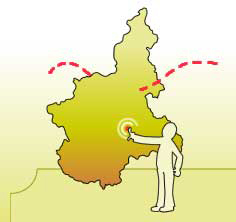Vision
The concept at the core of the PIEMONTE project is that smart things can play the role of gateways for enhancing the interaction between people and a territory with its cultural heritage. If physical things belonging to our everyday reality, whether human artifacts or elements of the landscape, could socialize with us, they could tell us about the world around them, its history and traditions, and especially share their network of relationships with other people or other key objects of the same territory.
Things are at the same time silent protagonists and witnesses of the history of a territory and of a community. If only they could remember what happened to them and around them and could tell stories about that, then the possibility of interacting with things could provide people with a significantly enhanced experience of the place they are staying in.
Università di Torino and Telecom Italia have thus joined forces with Università di Scienze Gastronomiche and Slow Food to elect as smart gateways the wines and food of a territory, together with their places, their producers, and those who work with them such as shops, markets and restaurants.
A Social Web of Intelligent Things
In order to bring forth this vision, the PIEMONTE project has devised the idea of a Social Web of Intelligent Things (SWIT). What features charachterize a SWIT? Here is our SWIT Manifesto:
- SWIT is about endowing real-life, concrete things, with intelligence and social abilities, that allow them to interact with people and among themselves. This first point encompasses the others which will clarify the type of intelligent and social behavior we expect from the things participating in a SWIT.
- People must be able to access the enhanced capabilities of a SWIT-thing in real life, at the same time as they access their standard capabilities. For example, one may want to listen to a wine telling the story of its production, or leave a comment on it, while he/she tastes it. Interaction should be bidirectional, e.g. on the one hand, the wine may start a conversation with the person who is looking at its label, asking if he/she wishes to listen to the production story, or to the messages left by those passing by; on the other hand a person may tell his/her stories to the wine or leave tags and comments on it. Interactions must be natural: this is a key point of a successful SWIT. Its goal is to enhance users' experience and not to make it awkward or cumbersome. People should not be forced to modify their habitual patterns of interaction with things when they participate in a SWIT; rather they should be gently and playfully led by interest, curiosity and fun to learn how to fully exploit a SWIT enhancement.
-
SWIT-things intelligence is based on their capability to reason on and learn from one or more of the following sources of information:
- semantic information such as system-provided common-sense and general knowledge about SWIT-things domain and environment (e.g. an ontology of wines, a map of the park);
- user behavior during interaction (e.g. How often does he/she pass by the bench? How often does he/she sit down? How long does he/she stay? Any clue about what he/she does on the bench?);
- Various types of content that people associate with the thing (e.g. messages or photos or tags that people virtually post on the bench).
- content aggregation, or the capability to filter, synthesize and mashup knowledge and user-generated content in a meaningful way, ranging from the intelligent selection of interesting media to digital storytelling;
- adaptation, i.e., the ability of adapting the interaction with each person;
- knowledge socialization, the capability of sharing knowledge with other things;
- social linking, or the capability to discover ties with people or other things that are suggested or implied by what users do or provide;
- serendipity, or the possibility for people to discover new, unexpected things or people by exploiting these newfound relations.
- SWIT-things and SWIT-users participate in a social network. A SWIT should provide all the functionalities of a social networking environment with the major difference that things are social actors and as such they can have their own friends and share information among themselves, thanks to the above mentioned intelligent functions. A SWIT social network thus maintains three types of dynamic relations: user-to-user (e.g. friendship, neighbourhood, similarity, etc.), user-to-thing (e.g. bookmarks, tags, like or dislike, potential interest, etc.), thing-to-thing (e.g. friendship, relatedness, similarity, etc.). It is worth mentioning that thing-to-thing relations define a new notion of proximity between things, that enables the serendipity feature we mentioned above. The intelligence and social abilities of a SWIT-thing are not juxtaposed features, but they are deeply interconnected, as much as they are in human beings.
Prototyping and Development
The SWIT concept is instantiated in the PIEMONTE project through a novel framework called WantEat, made of a suite of client-server applications. WantEat is based on three main ideas:
- enhancing the user experience by supporting playful interaction with a web of things,
- embedding social intelligence in things,
- extending the notion of social networking from people to things.
In other words, WantEat further develops the above mentioned idea of a social web of intelligent things into a social web of intelligent things and people, where both things and people are social entities, able to manage and share knowledge and to establish relations with other things and people.
A key feature of WantEat is that the interaction with things is not merely a way of getting information or sharing comments and experiences with a community of users, as it is common on classical thematic social networks, but it is an opportunity for getting in touch with all the world behind a certain thing and with a network of people and other things related to it. In this sense the social network entities play the role of hubs, allowing to "leave" for different destinations and discoveries.
As we already said, the domain of application of WantEat is gastronomy, as a way of getting in touch with the traditions and cultural heritage of a territory. Things include food products, market stalls, restaurants, shops, recipes, but also geographic places and actors such as cooks, producers, shop owners, etc. Interacting with a certain food product (e.g., a bottle of wine) is a way of getting in touch with the cultural heritage behind it, made of stories and traditions, as well as with the social network of its friends, made of grapes, producers, shops, but also people who talked about it, tasted and liked it, recipes that match well with it, or other products (e.g., a cheese traditionally served with the wine). This is in line with the philosophy of Slow Food: advocating a new model of sustainable gastronomy, where food is good, clean and fair and where people are aware of the territory they live in or visit, of its resources, history, traditions and of the actors and the processes in the chain. A sustainable gastronomy relies on preserving the biodiversity of a territory, promoting and supporting its quality food, making consumers aware of that quality, creating networks of actors sharing experiences and shortening the supply chain. In this view consumers become co-producers, as their choices have a direct impact on the production chain.








